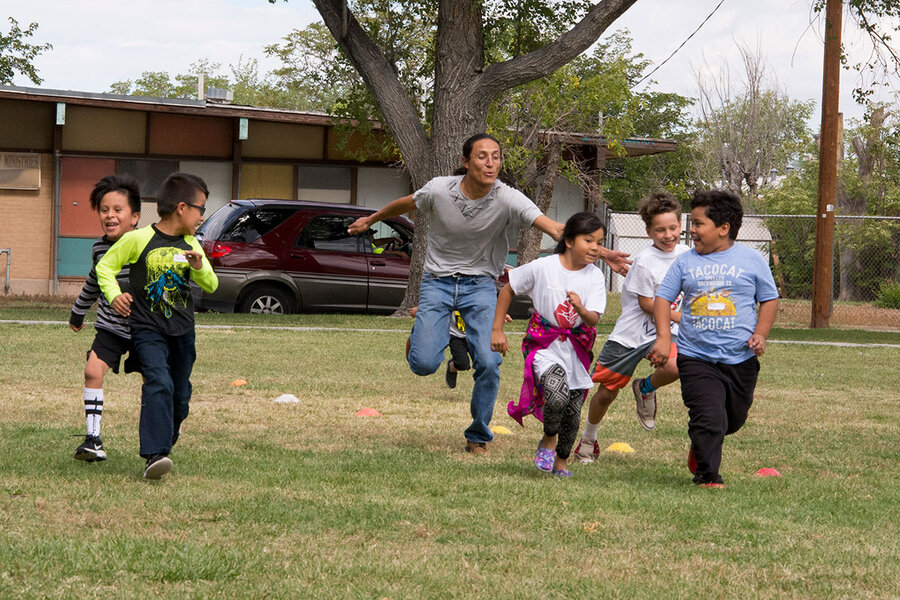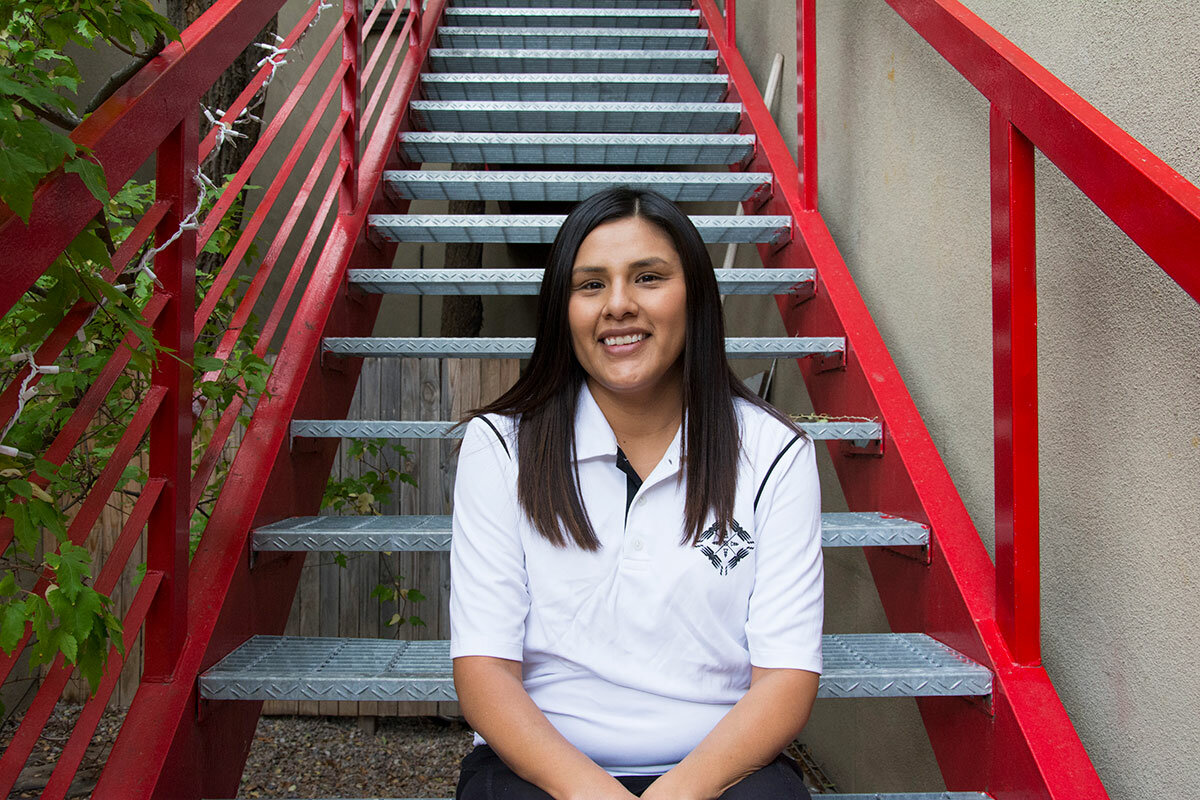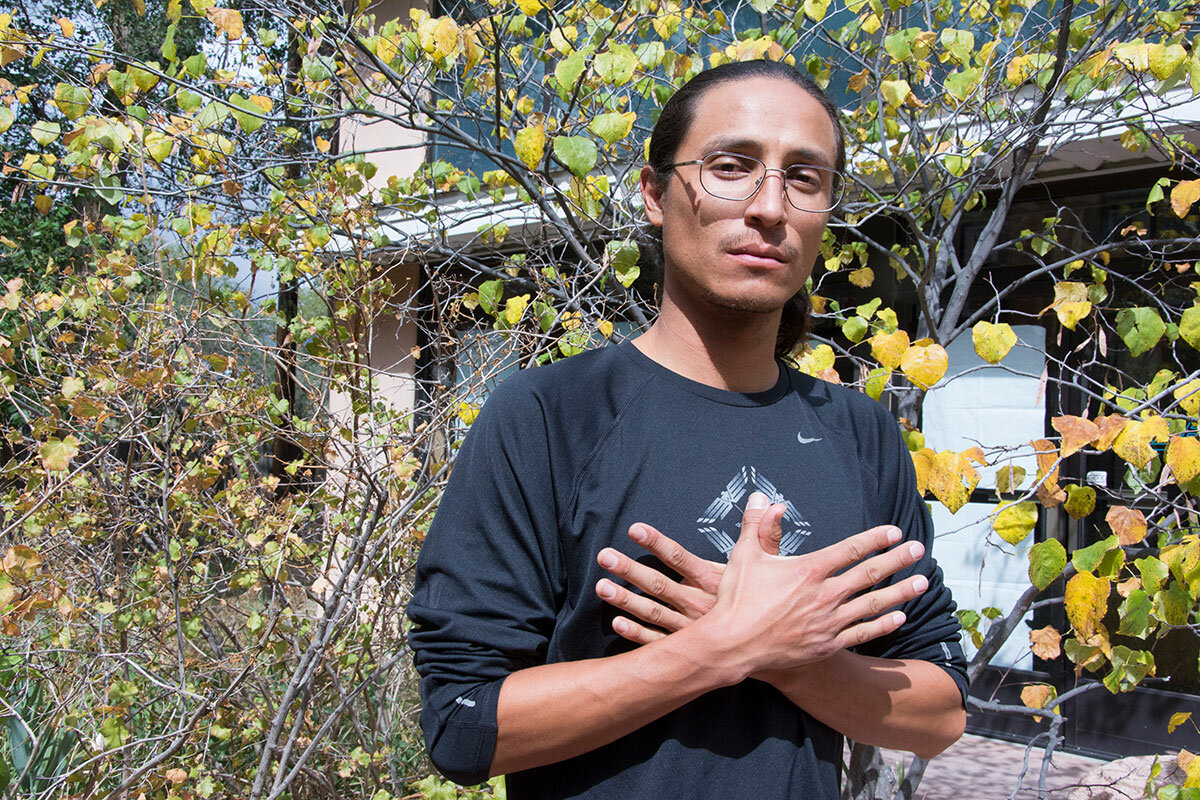For young Native Americans, running is a lesson in their own history
Loading...
| SANTA FE AND ALBUQUERQUE, N.M.
Just as their ancestors ran to communicate with others, today the young Native American athletes of Wings of America run to deliver messages of self-worth, cultural pride, and hope. Native Americans have practiced prayer runs for generations to spiritually connect with or give gratitude to Mother Earth. And hundreds of years ago, Native Americans relied on messenger runners to communicate with other tribes. In one of the Wings programs, elementary students in Albuquerque warm up, stretch, and, of course, run. But they are also sure to spend time in a circle, talking about Native Americans’ connection to running and how it can be a form of activism. This past March, Dustin Martin, the executive director of Wings, helped organize an 800-mile prayer run to Bears Ears National Monument in Utah. “Everyone else in Indian country, unfortunately, for the last 30 years, has had to build a program on the premise or idea that something was deficient: ‘We’re preventing substance abuse, preventing domestic violence, we are trying to mitigate the poverty rate.... We’re fixing you somehow,’ ” says Martin. “But our association with Wings defines us as more than those things.”
Why We Wrote This
Great teachers can make a lifelong impression and inspire learning across disciplines. Wings of America coaches seek to help kids overcome stereotypes with stories of Native American athleticism and advocacy.
A plume of dust trails his worn sneakers as he strides over the red sand.
Most runners would find this surface trying: a sinking, winding path, made narrow by low desert brush. But not Dustin Martin. He glides over the sand – seemingly without sinking at all – as if he and the Earth made a deal long ago.
Mr. Martin, a Navajo from Gallup, N.M., is executive director of Wings of America, a nonprofit based in Santa Fe, N.M. It encourages Native American youth to embrace running, both as a cultural tradition and as a personal hobby, while simultaneously helping to dispel negative stereotypes associated with their peoples.
Why We Wrote This
Great teachers can make a lifelong impression and inspire learning across disciplines. Wings of America coaches seek to help kids overcome stereotypes with stories of Native American athleticism and advocacy.
“Everyone else in Indian country, unfortunately, for the last 30 years, has had to build a program on the premise or idea that something was deficient: ‘We’re preventing substance abuse, preventing domestic violence, we are trying to mitigate the poverty rate.... We’re fixing you somehow,’” says Martin. “But our association with Wings defines us as more than those things.”
To be sure, Native American youth confront many statistics that back up these stereotypes. Obesity is said to affect 50 percent more Native Americans than white Americans, Native youth have more depressive episodes and emotional issues in the classroom. And while newer studies challenge the prevalence of alcohol abuse, the stereotype persists.
But for three decades, Wings has encouraged Native Americans to shake off these labels. Just as their ancestors ran to communicate with others, Wings of America runners today run to deliver different kinds of messages. Messages of self-worth, cultural pride, and hope.
“Running is good for everybody … but the dial is turned up, this is amplified, in Native American culture,” says Daniel Lieberman, a professor of human evolutionary biology at Harvard University, who has researched the history of Native American runners. “They have such an amazing cultural tradition of running and then you add to that some of the challenges that kids are facing on the reservation. There are multiple compelling reasons to support a program like Wings.”
The example of Jim Thorpe
On a browning soccer field off Albuquerque’s buzzing Interstate 40, dozens of elementary school students run in circles, squealing. They are playing a game of tag. The students have a scarf tucked into the back of their pants or skirts and they try to steal others’ scarves while protecting their own.
Martin and Wings’ program coordinator Alicia Littlebear are hosting “Flight Club” for elementary students at the Native American Community Academy in Albuquerque. Twice a week the students practice warm-ups, stretching, and, of course, running. But they are also sure to spend time in a circle, talking about Native Americans’ connection to running.
Native Americans have practiced prayer runs for generations as a way to spiritually connect with or give gratitude to Mother Earth. And hundreds of years ago, before horses were readily available across North America, Native Americans relied on messenger runners to travel hundreds of miles to communicate with other tribes.
“Running doesn’t come out of the blue. Its roots are ancient and deep,” says Professor Lieberman. “Those roots have been lost and Wings is trying to revive them in a modern context.”
Martin and Ms. Littlebear teach the students about Tom Longboat, from the Six Nations Reserve in Ontario, who consistently beat other famous runners of the early 1900s in races more than 20 miles long. He won the Boston Marathon in 1907 with a time that was almost 5 minutes faster than any of the previous 10 winners. And they talk about Ellison “Tarzan” Brown, of the Narragansett tribe in Rhode Island, who won the Boston Marathon twice, in 1936 and 1939, and Patti Catalano Dillon, whose mother was a Micmac from Nova Scotia, and who became the first American woman to finish a marathon in under 2 hours and 30 minutes and won the Honolulu Marathon four years in a row, beating her own course record each time.
Martin and Littlebear also teach the students about Jim Thorpe, who grew up in the Sac and Fox Nation in Oklahoma. The first Native American to win Olympic gold for the United States, he’s one of the most versatile and accomplished US athletes in history. Lewis Tewanima, a Hopi runner from Arizona, was Thorpe’s fellow Olympian in 1912. Tewanima’s silver medal remained the best performance by a US athlete in the 10,000 meters until Billy Mills, another Native American, won gold in the event at the 1964 Tokyo Olympics.
But Martin seems most impressed by the context of these athletes’ success. Many of them were sent to boarding schools against their will, a common trend in the early 1900s, to force the “Americanization” of young Native Americans. Thorpe and Tewanima, for example, trained together for a few years at the Carlisle Indian Industrial School – whose founder coined the phrase “Kill the Indian, Save the Man” – before winning at the Olympics.
“To have the strength, not only of the body, but of the mind and heart, to compete for your oppressor?” says Martin. “To be humble and say, ‘I’m going to run, but I’m running for something else.… I want to use what is obviously the ability that my people gave me.’ ”
Sending a message in a run
As the young students gather in a circle on the soccer field, Martin apologizes for missing a Flight Club and asks the students if they would like to hear about the run in Nevada he attended instead. The circle nods in unison.
The Water Protectors Sacred Run in Nevada in October was a protest against the Southern Nevada Water Authority pipeline, a project that would pipe groundwater from central and eastern Nevada to Las Vegas. The pipeline was denied a permit in August and is being appealed. But participants such as Martin see the process as yet another affront to Native peoples’ right to natural resources.
“We don’t want people to forget that. I don’t want you guys to forget that,” says Martin, after having explained to the Flight Club members that they can be the guardians of their rights to the Earth. “Now go run two laps.”
Along with teaching the students about Native Americans’ historical connection to running, Wings teaches how running can be a form of activism in the children’s future. This past March, Martin helped organize an 800-mile prayer run with members of local tribes and pueblos to Bears Ears National Monument in Utah, a monument with significance to Native Americans, which President Trump recently shrunk by 85 percent. Outside Magazine named Martin one of 2018’s boldest activists.
To Littlebear and Martin, Wings is just getting started. In addition to Flight Club and summer camps, Wings brings top runners to the junior USA Track & Field Cross Country Championships race each year. The work is a manifestation of their generation’s will to change the way the rest of the country sees – and treats – Native Americans.
“Our hearts hurt when politicians or educators don’t take us seriously, or they’re not ready to see us succeed, or they doubt us. Like it’s really hurtful in your heart to know that this is what they think about you,” says Littlebear, as she starts to tear up. “We’re the first generation that’s really being vocal.… So our kids won’t have to suffer that.”
As the NACA students stand up to start their run, a kindergartner named Kiana is complimented on her moccasins. She looks down at her feet thoughtfully.
“I’m not used to running in them because I run barefoot on the res,” says Kiana. “Cause I’m a Navajo and that’s what Navajo do.”










